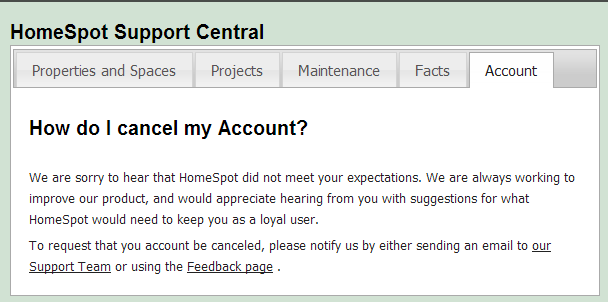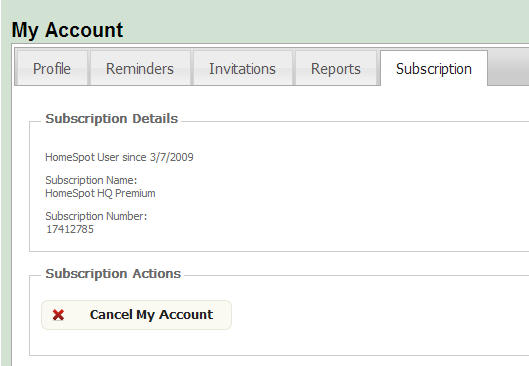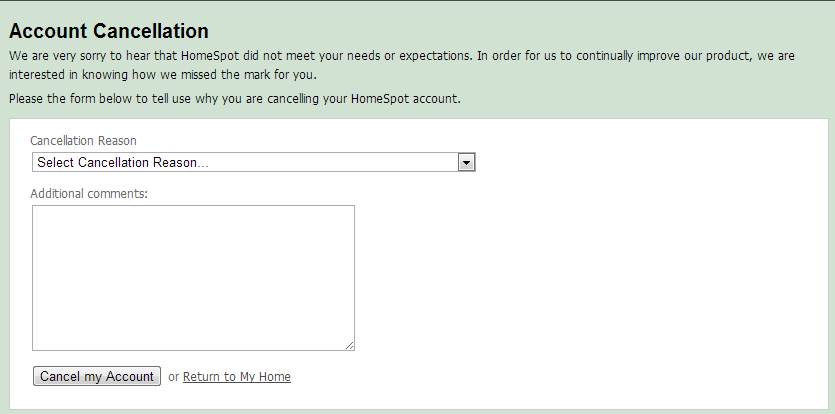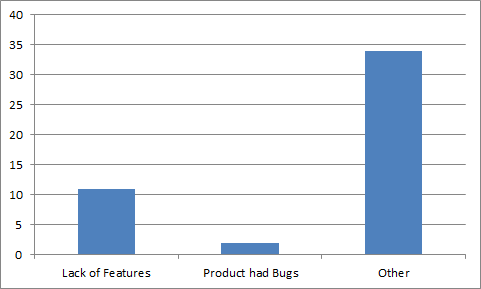One of the less promoted new HomeSpot features we added this year was a way for a user to cancel their account. I debated adding this option at all. While I wanted to believe that every person who signed up for HomeSpot would love it as much as I do, I didn’t want to be the site that locked you in unwillingly to something that just wasn’t for you.
For the first four years since HomeSpot released, if a user wanted to cancel their membership, we asked them to email our Support desk or submit the request through our Feedback form. In our support pages, we had a simple FAQ entry to help guide the user:
The hope was that if we had a more specific cancellation request form, we could get better feedback about how our product wasn’t meeting people’s expectations. So first, in the My Account page, we added a Cancel Account button.
This linked to a new page where we solicited the reason for why someone wanted to cancel their account.
And then we created what we thought were legitimate reasons a user may have, each one asking them to provide us some feedback in the comments field.
Since deploying this feature, we’ve had about 50 users cancel using this form. And I’ve learned that you have to be careful what you ask for. Feedback from users can illuminate opportunities; it also can sting a bit.
Here’s a breakdown of the reasons provided from those who have canceled their accounts.
Less than half of the users actually provided any additional comments. I chose not to make this field required, out of courtesy to departing users. So while they may have selected Lack of Features, they weren’t willing to tell us what they wanted, so I can’t help them.
Another set of responses I found interesting were those who complained about a missing feature that is actually in the product, meaning they couldn’t find the feature, or simply misunderstood it. For example, one user wrote
Works better if I do it myself on Google calendar instead of setting up a separate account.
HomeSpot has the ability to publish your home’s maintenance schedule to a Google calendar, which could have assisted this user. Another case was a comment that read
Option to delete reminders that don’t apply to my home. I don’t need to clean a garbage disposal since I don’t have one.
In this case, they must not have realized that the Delete this item button is shown when you actually view the item (rather than showing on the list view).
Most disappointing were the various forms of the comment “I don’t use it.” or “doesn’t meet my needs.” These are informative to the degree that any improvements we can make to foster user engagement will help draw users back to the product. Still, sometimes the truth hurts.
Improving User Feedback
There are lots of ways we may continue to try to get feedback from our users. One simple step will be to put links to our feedback and support pages on the Cancellation page, which may help answer some of the feature related questions or complaints.
Another approach may be to add a user forum component to our product, whereby users can post questions and get feedback from other users or our Support team directly. This approach would help make visible the questions and complaints from the user base and provide our responses to be globally available to all users.
With HomeSpot, we have always tried to listen first, then act, whether it is when adding premium features or updating our list of home maintenance tasks. Our users think of things that often never occur to us. But we’ll never know these ideas if we can’t effectively ask for and capture their input. And reviewing and adapting to those responses is critical to our ability to stay competitive.
So yes, asking for user feedback is worth it. You may be surprised at what you get.





Leave a Reply